The ‘Left-To-Die boat’ : ten years on, it’s more urgent than ever to obtain justice for the shipwrecked
Topic
12 April 2021
A joint statement on the tenth anniversary of the 'Left-To-Die boat' case, in which 63 people died after being left adrift at sea despite multiple authorities and vessels knowing of their location and situation.
Support our work: become a Friend of Statewatch from as little as £1/€1 per month.

Statement originally published by Migreurop on 11 April 2021, also available in French and Spanish.
Ten years ago to the day, on April 10th 2011, eleven people ran aground on an inflatable boat near Zlitan, on the Libyan coast. After drifting for two weeks in the Mediterranean, the survivors were barely conscious. A woman died on the beach. A man died a few days later in the prison where he had been thrown by the Libyan military, along with his fellow survivors.
The nine survivors were part of a group of seventy-two people crammed by Libyan smugglers onto an inflatable boat that left Tripoli on March 27th for the island of Lampedusa, in Italy. The boat’s fuel reserves had run out halfway. Sixty-three of them died a slow death as this boat that became their coffin floated around aimlessly before being finally forced back by the winds and currents towards the Libya that they had fled.
The smugglers were not the only ones responsible for this tragedy. In the maritime zone that the passengers tried to cross, thirty-eight warships were deployed off the Libyan coast as part of an operation led by a coalition of states and NATO. In the words of an Italian officer, "sailing from Libya to Italy was like slaloming between battleships".
What’s more, the maritime area was very closely monitored. During their odyssey, the seventy-two passengers were spotted on several occasions by the air fleets of the forces involved, starting with a French military aircraft which was the first to detect the boat. All the boats transiting in the area were alerted by distress signals emitted by the Italian coast guard asking them to assist the passengers. On two occasions, a helicopter with "ARMY" written on its side flew over the boat people, even throwing them bottles of water and biscuits before disappearing. Despite these repeated interventions and the knowledge of all the protagonists operating in the area of their long agony, the passengers were left to their fate. When the boat drifted close to a military ship a week after running out of fuel, its crew simply photographed the boat people who were begging for help, before moving away.
By their indifference, all those who saw this ‘left-to-die boat’ killed sixty-three people, without even touching their bodies.
The nine survivors, supported by a coalition of associations, have for ten years been asking that the crime of which they were victims be recognized and those responsible prosecuted. In spite of their concordant testimonies, in spite of the evidence gathered by several investigations - including those of the Parliamentary Assembly of the Council of Europe [1] and experts of Forensic Oceanography, [2] - the courts before which the complaints were filed - in Italy, France, Spain and Belgium - have so far been blind to the gravity of the facts, and deaf to the demand for justice for the survivors of the ‘left-to-die boat’.
If we are to believe the implicated States, the world’s most closely watched maritime zone seems to have been only a theatre of shadows.
The impunity that is still covering this crime is unacceptable. "I continue to demand justice because I witnessed this tragedy," says Abu Kurke Kebato, one of the plaintiffs. "It would have been easy for those who approached us and even gave us food to save us. I hope that a judgment will be rendered soon. "
This impunity is encouraging practices of non-assistance that have continued to multiply since : on October 11th 2013, more than two hundred people drowned in the vicinity of the island of Lampedusa, due to the slowness of the Maltese and Italian authorities in organizing the rescue. Four survivors have filed a complaint. [3] The end of the Italian Mare Nostrum operation in 2014, [4] followed by the policy of "closed ports" put in place by Italy, [5] have only reinforced the phenomenon.
Today, non-assistance has become a policy. By refusing exiles access to European borders, and by shirking their obligations to provide assistance, European states are doubly responsible for the tragedies that plague the migration routes. The list of more than forty thousand people who have died at Europe’s borders since the beginning of the 1990s continues to grow, day after day. [6]
Ten years on, it is too late to repair the damage. But it is more urgent than ever to obtain justice for the castaways of the ‘left to die’ boat and to put an end to a "murderous Europe". [7]
Signatory organizations : Agenzia Habeshia ; Alarmphone ; Arci (Associazione ricreativa e culturale Italiana) ; Asgi (Associazione per gli studi giuridici sull’immigrazione) ; Boats4People ; EuroMed Rights ; Fédération internationale pour les droits humains ; Forensic Oceanography ; Groupe d’information et de soutien des immigrés ; Global Legal Action Network ; Ligue des droits humains belge ; Ligue des droits de l’homme ; Migreurop ; UFTDU (Unione forense per la tutela dei diritti umani).
On the ’Left-to-die boat’, see also :
- "Faire émerger la responsabilité des États", interview of Charles Heller and Lorenzo Pezzani
- Liquid traces, the ’Left-to-die boat’ investigation
- Joint press release, 63 migrants morts en Méditerranée : l’armée française mise en cause pour non-assistance à personne en danger
- A file on the case on Gisti website
Image: Paul Downey, CC BY 2.0
Our work is only possible with your support.
Become a Friend of Statewatch from as little as £1/€1 per month.
Spotted an error? If you've spotted a problem with this page, just click once to let us know.

